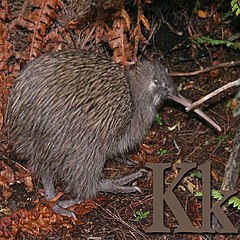
 I’d like to share 25 Interesting Facts About Kiwi Birds with you. I think everyone knows that the Kiwi Bird comes from New Zealand. I’m hoping that while writing this post, memories of my trips there many years ago will come back to me.
I’d like to share 25 Interesting Facts About Kiwi Birds with you. I think everyone knows that the Kiwi Bird comes from New Zealand. I’m hoping that while writing this post, memories of my trips there many years ago will come back to me.
The Kiwi Bird is the national bird of New Zealand and you’ll see its symbol emblazoned on any kind of merchandise you might find, along with the silver fern. The bird is treasured especially by the Maori people and its significance for them is held in very high regard in spiritual, cultural and historic situations dating back generations.

As a side note, the Kiwi people gained their nickname from a brand of shoe polish during the 1900s, when the inventor named it after a bird from his wife’s native country. The polish became so popular that ever since then, Kiwi has come to mean anyone from New Zealand. So as you can see, the Kiwi Bird is a very proud symbol to the people of NZ.
25 Interesting Facts About Kiwi Birds (in no particular order)
1. The Kiwi Bird is nocturnal, the size of a chicken.
2. There are approximately 68,000 left in the wild and every week, numbers decrease.
3. Sometimes called an “honorary mammal” due to its hair-like plumage. The female also has two working ovaries which is unusual in birds.
4. The only bird to have nostrils at the end of its bill, not at the beginning.
5. Kiwi Birds do not fly and consequently, they do not migrate.
6. Their bill can measure up to 15cm (6in), perfect for digging around in the night soil for their food. Officially though, they have the shortest beak of all birds because the measurement should be from the tip to the nostrils. It is curved at the end.
7. They are monogamous animals. Some relationships can last for 20+ years.
8. Their wings measure only 4-5cm long. Each wing masks a claw in the feathers.
9. On each foot, they have 4 toes and plump pads so they can move around easily and silently on the forest floor.
10. They do not have a tail.
11. Dinosaur-like, they don’t have the same bone structure in their mouths and jaws like other birds.
12. Classification: Order Apterygiformes / Family Apterygidae / Genus Apteryx / 5 species. Apteryx means wingless in Latin. They are the smallest bird from the same family as the ostrich, emu and cassowary.
13. Species: the brown kiwi, the great spotted kiwi, the little spotted kiwi, the rowi and the tokoeka. The brown kiwi can be separated into the Stewart Island brown, the North Island brown and the South Island brown (Stewart Island). Then there are variations of each (referred to as taxa) as seen in this diagram:
 Screenshot taken with thanks from https://www.kiwisforkiwi.org/about-kiwi/kiwi-species/
Screenshot taken with thanks from https://www.kiwisforkiwi.org/about-kiwi/kiwi-species/
14. They cannot be found in the Northern Hemisphere in the wild.
15. They can live between 25-50 years.
16. Males reach sexual maturity at 18 months of age. To attract a female, the male will sing and use pure perseverance and stamina until the female succumbs. The female is bigger than the male so she will determine whether mating will take place or not. Mating season is between June to March and failure to produce offspring can result in “divorce”.
17. A Kiwi’s eyes are very small in comparison with other nocturnal animals. These birds are particular in that the parts of their brain dedicated to touch and smell are much larger and so, large eyes were deemed not necessary by evolution.

18. Although nocturnal creatures, these birds have very poor eyesight and use their olfactory, tactile and auditory senses to amble around and search for food. Quite noisy when hunting (they make snuffling noises as they smell out their food), their bills and whiskers are extremely sensitive to finding nourishment in the soil and fallen leaves. They will use their nostrils to smell prey and feel the vibrations the prey makes. They can detect prey 3 cm beneath the surface and then they dig deeper to pull out their find.
19. While others are nocturnal, you might be lucky enough to spot the Stewart Island tokoeka during the daytime too.
20. It looks like they do a kind of handstand when they dig for their prey.
21. Omnivores, they eat worms and other insects that move up to the top of the soil after dark. Also, berries and seeds. Little water as this is gained mostly from insects.
22. For nests, they will find or dig burrows in the earth.

23. The female (sexually mature around 3-5 years old) will lay 1 or 2 eggs which hatch after 70-80 days of incubation by the male. Only about 5% of hatchlings will survive, the others will be hunted mainly by stoats or cats. Hatchlings are born with plumage and they feed alone (after about 5 days in the nest), never by their parents, although the parents will care for their welfare.
24. The main predator of an adult kiwi bird is the dog or the ferret. A gentle nudge from a dog is all that is needed, let alone a grasp in a dog’s jaws.
25. Scientists know that the kiwi evolved 70 million years ago from a flightless ancestor and are still, to this day, working through the origins of this bird and where it’s relative DNA is connected to. Some say the emu; some say another bird called the elephant bird from Madagascar (now extinct) and when and how it came to be found on the islands of New Zealand.
25 Interesting Facts About Kiwi Birds

Humans are again to blame for the demise of this bird. Deforestation, fire, traffic collisions and the introduction of some mammals to the islands, namely cats, dogs, stoats and pigs have reduced numbers drastically.
Conservation programmes exist to protect this unique creature in the wild and on land where predator numbers are controlled. There are also islands free from natural hunters. Approximately 20% of these birds are so far protected but the rest could so easily be eradicated by introduced mammals. Would you like to help protect the Kiwi Bird? Please visit HERE for info.
Have you ever seen a Kiwi Bird in the wild? Where did you see it? Do you know which species it was? I’d love to read about your experiences in the comments below. Thank you for reading ?
Key References:
“Animal - The Definitive Visual Guide to the World´s Wildlife” - Editor-In-Chief David Burnie
The Amusing Kiwi Beaks
Facts about kiwi: NZ Native birds
New Zealand's icon :: Kiwis for kiwi
"Order Apterygiformes / Kiwis and Extinct Birds," in Bio Explorer, June 1, 2020, https://www.bioexplorer.net/order-apterygiformes/.





Hello and thank you for writing this interesting article on the Kiwi birds, I have never heard of this bird before reading your article so this is really a new experience for me.
I am looking forward to your next article, and I can’t imagine what you might share next time
Jeff
Hey,
I found this article very interesting indeed, and I really enjoyed reading through your other articles.
I have a friend who is an animal lover just like you (I am too) and I think he would love your site.
I have forwarded your article onto him and I have encouraged him to comment. If he has any questions then he will get in touch.
Thank you for sharing and keep up with the great work.
All the best,
Tom
Thank you for this information. I have heard of kiwi birds but had known that they could not fly since I assuemed all birds fly.
It is also interested to see that they do not migrate and have nostrils at the end of their beaks, unique birds indeed.
Hi Jeff, thank you for your kind comments. I´m pleased I was able to introduce you to this bird, another animal in need of protection. Re next time, who knows! lol Thanks ?
Hello Tom. Thank you and thanks for sharing! All the best to you too ?
Hello Thabo. I´m glad you found this post interesting. They are indeed a very unique bird ?
I did not know the kiwi birds were the size of a children, they don’t fly and they don’t have a tail!
These bird look super cute but unfortunately the number is declining.
Thank you for sharing these 25 interesting fact about kiwi birds with us.
I´m not sure I actually wrote they were the size of a child haha. It´s true, numbers are decreasing and it´s such a such. Luckily, there are organisations out there helping to increase the population of Kiwi Birds again. Thank you Habib.